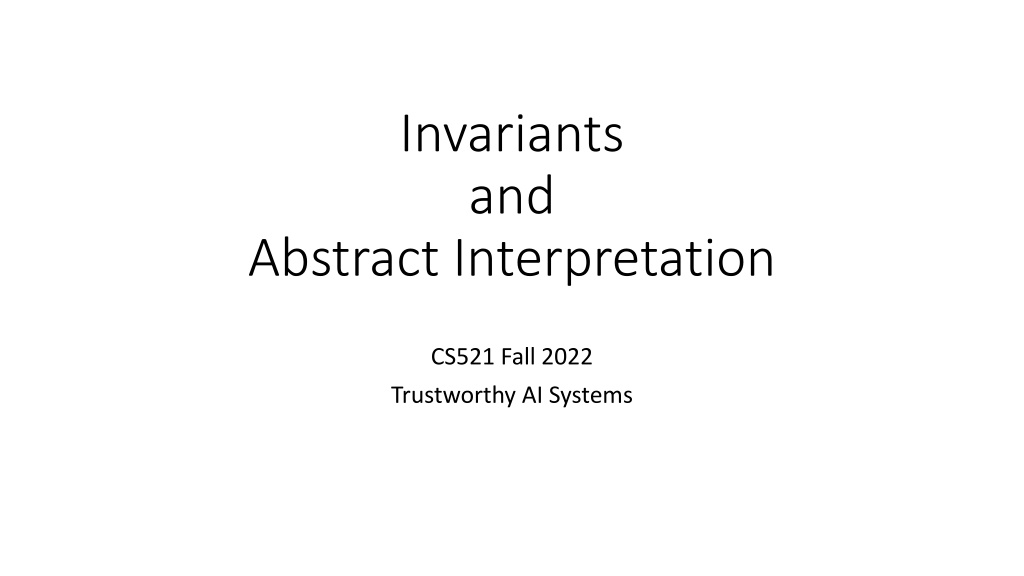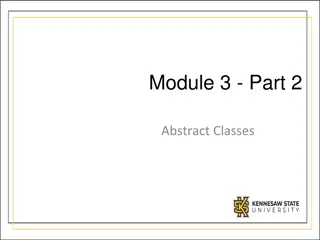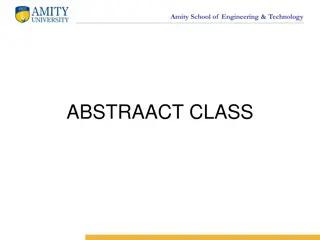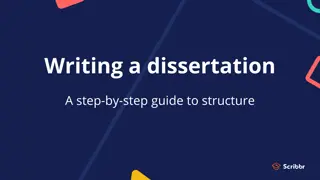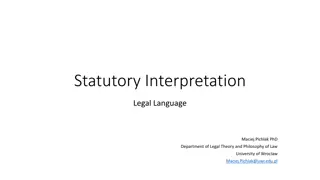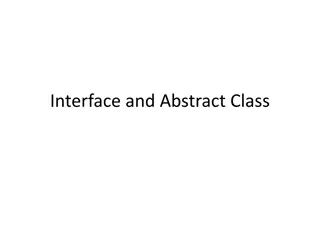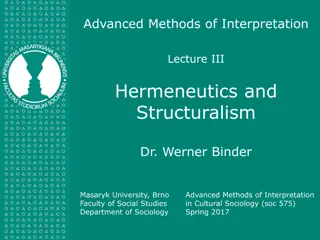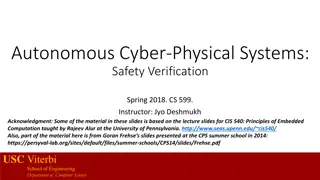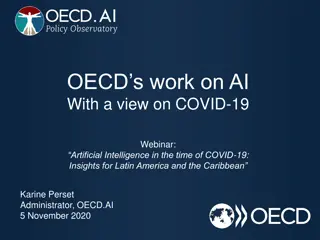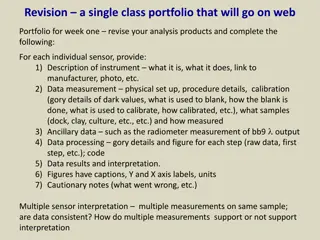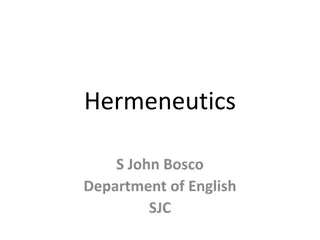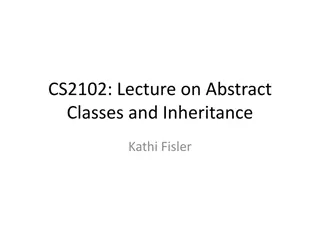Understanding Invariants and Abstract Interpretation in Trustworthy AI Systems
Invariants and Abstract Interpretation are crucial concepts in building trustworthy AI systems. This involves defining configurations, concrete semantics, set semantics, and handling programs with loops. Monotonic functions play a vital role in ensuring consistency in the interpretation of these systems.
Download Presentation

Please find below an Image/Link to download the presentation.
The content on the website is provided AS IS for your information and personal use only. It may not be sold, licensed, or shared on other websites without obtaining consent from the author. Download presentation by click this link. If you encounter any issues during the download, it is possible that the publisher has removed the file from their server.
E N D
Presentation Transcript
Invariants and Abstract Interpretation CS521 Fall 2022 Trustworthy AI Systems
Programs Configurations: Fix a finite set of variables ? = {?1, ,??} ranging over certain domains ? = { ?1, ,??} Configuration: valuation of variables over the domains Note: pc, or program counter can also be a variable Concrete semantics of statements s: ??:???? ???? Takes any configuration to the next configuration E.g., s:``x := x+1 has the semantics as the map ??that maps conf to conf where con? (x)= conf(x) + 1; conf (y) = conf(y) for every ? ?
Set semantics Extend semantics to sets of configurations For a set X of configurations, ??? = ??? ? ? } Example: ?1; ?2; ?3 Input set: I Output set: O I ?1 ?2 O ?? ??1 ??2 ?1= ?1 ?2= ?2 ?3= ?3 Given I, O is uniquely defined by the above equations.
Set semantics for programs with loops ?1; ? ??? ? ?? { ?2 } ; ?3 Input set: I Output set: O I ?2 ?3 O ?1 ?? ?2 ??2 ?1= ?1 ?2= ?1 ? ?3= ?1 ? ? = ?3 ? ?3 Given I, is O is uniquely defined by the above equations? Not quite. We need the least solution satisfying the above equations.
Set semantics for programs with loops ?1; ? ??? ? ?? { ?2 } ; ?3 Input set: I Output set: O I ?2 ?3 O ?1 ?? ?2 ?(?2) ?1= ?1 ?2= ?1 ? ?3= ?1 ? ? = ?3 ? ?3 Given I, is O is uniquely defined by the above equations? Not quite . Many solutions possible because of loop in defs (?1 ..?2..;?2 ..?1) We need the least solution satisfying the above equations.
Monotonic functions Let ?, ?? ? ??? ??? ? ??????? ????? ?:? ? ?? ????????? ?? For every ?,? ?, ?? ? ? ? ?? ? ? ?(?) f takes larger values to larger values Are the functions applied in the concrete semantics monotonic? (wrt to ???? ?? ?????, )
Monotonic functions Definition of monotonic functions does not say: ? ? ? for every ? ? Functions need not map elements to larger elements. E.g., Is ? ? = ? ? ? ?? ????} monotonic? (over sets with ) E.g., Is ? ? = ?????????? ?? ? ?????????? E.g., Let ? be defined ``point-wise : ? ? = ? ??(?) Is ? always monotonic?
General form for semantics ?1= ?1 ? ?2= ?2 ? where each ??is monotonic ??= ?? ? In programs without loops, there are no interdependent definitions. In programs with loops, there are interdependent definitions.
Abstract Interpretation Concrete Semantics: (?????, , , ) ?1= ?1 ? ?2= ?2 ? ??= ?? ? Imagine that I just swapped the domain! ????, , , (?, , , ) D is some set with a partial order , least upper bound , greatest lower bound . But of course the f s must change.
Abstract Interpretation Concrete Semantics: (?????, , , ) ?1 = ?1 ? ?2 = ?2 ? ?? = ?? ? Alternate Semantics: (?, , , ) ?1 = ?1? ? ?2 = ?2? ? ?? = ??? ? Swap ?????, , , (?, , , ) D is some set with a partial order , lub , glb . ?? ?:? ? are some monotonic functions
For programs with loops/eqns with loops More structure is needed. (?, , , ) Complete Lattice: Every subset S of D (including infinite subsets) has a least- upper-bound and a greatest lower bound. Tarski-Knaster Theorem: If you have equations with monotonic functions on a complete lattice, then the lfp (and gfp) for them exist (and is unique of course). Relaxation: we don t need , existence of greatest lower-bounds, etc. and existence of lub suffices.
Box/Interval Domain ?: Intervals Ordering on intervals c,d [?,?] iff e ? ??? ? ? : Least upper bound on intervals ?,? , ?,? = min ?,? ,max ?,? ?: Abstract post on intervals ?? For example: +?([?,?],[?,?]) = [? + ?, ? + ?]
When is an alternate interpretation an abstraction? Concrete Semantics: (?????, , , ) ?1 = ? ?2 = ?2 ? ?? = ?? ? Alternate Semantics: (?, , , ) ?1 = ???(?) ?2 = ?2? ? ?? = ??? ? Program is correct with concrete semantics if ?? ?. Program is correct with alternate semantics if we start with ?1= abs(I) and find Xn ???(?). Soundness: pgm correct with alt semantics => pgm correct with conc. Semantics But surely we need to connect the domains in some way first!
When is an alternate interpretation an abstraction? Concrete Semantics: (?????, , , ) ?1 = ? ?2 = ?2 ? ?? = ?? ? Alternate Semantics: (?, , , ) ?1 = ?(?) ?2 = ?2? ? ?? = ??? ? ?: ????? ? ? ????? Introduce abstraction function and concretization function ?: Gives ``meaning to the abstraction.
? ??? ? for Interval/Box Example: ? ? = ??: min ? ??(??),max ? ??(??) > Maps R to smallest intervals that contain R ? ??: ??,?? ) = ? ?(??) ??,??,for each ? }
Overapproximation: requirement on domains Galois connection: ?????, , , ? (?, , , ) ? ? ? ??? ? are monotone If ? ?, ? ? ? ? ; If ? ? , ? ? ? ? ? ? ? ? (in fact, this is usually =) ? ? ? ? Check these for box domain.
Overapproximation: requirement on abstract transfer functions Given ?: ????? ????? and ??:? ? when does ?? correctly abstract ?? ??? If ? ? ?, ? ?? ? ? ? for any ? ?????,? ? ??? ? . In particular, ? ? ? Again, check this on interval domain.
Soundness If the conditions on the domain being related by Galois connection and the condition on the abstract transfer function hold, then the abstraction is correct. If we prove in the abstract semantics, starting with ? ? that ? ??? is unreachable, then in the concrete system, starting with ?,??? is guaranteed to be unreachable.
Invariants, again Concrete Semantics: (?????, , , ) ?1 = ? ?2 = ?2 ? ?? = ?? ? Alternate Semantics: (?, , , ) ?1 = ?(?) ?2 = ?2? ? ?? = ??? ? Take a solution for ?1, ,??over the abs domain ?1, ,?? that proves ? ? is unreachable. Consider for the concrete domain, setting each ??= ? ??. Then for each i, ?? ?_?( ?), and ?? ??? is empty. Which in fact means this valuation is an invariant of the system! And the invariant proves that O is unreachable! PREFIXPOINT
Invariants, again So abstract interpretations can compute invariants. Typical pros of fixed abstractions: Fast computation as the abstract post can be reasoned with using human ingenuity, mathematics, and optimized algorithmically in advance. Typical cons of fixed abstractions: Stuck if abstraction doesn t prove property Many other techniques in program verification Counterexample guided abstraction refinement (CEGAR) Change the abstraction according to property; e.g., CEGAR for predicate abstraction in proving device drivers correct (SLAM/SDV@Microsoft) But refinements and dynamic abstractions are expensive (need SMT solvers) Conjunctive invariant learning (Houdini, Sorcar): Used in SLAM/SDV Interpolation and IC3 (McMillan; Bradley) ICE learning (M s group) Program/expression synthesis (SyGuS, CEGIS) Trace abstraction using automata and SMT unsat cores (Podelski et al)
Salient points to remember Abstract analysis is really evaluating a program with an alternate semantics over an alternate domain (think about interval domain) Semantics is given by monotonic functions ? and ? maps are useful ways of formalizing the meaning of the abstraction, formally Galois connections and the condition on abstract transfer function formally tell you what you have to prove to show soundness Abstractions eventually compute invariants. In practice, some of the requirements for abs int we have can be relaxed a bit.
